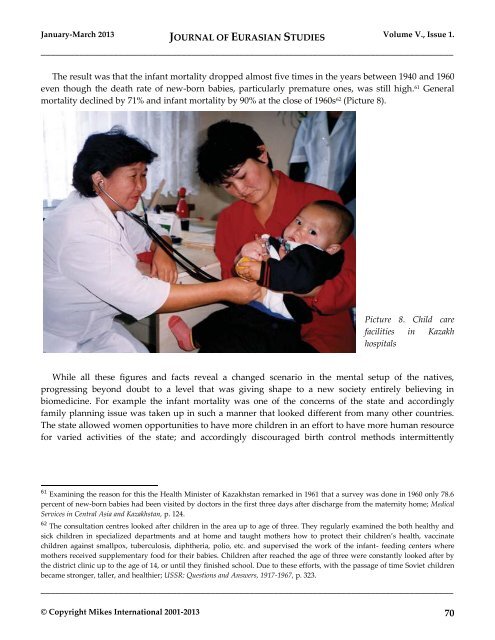JOURNAL OF EURASIAN STUDIES Journal of the Gábor Bálint de ...
JOURNAL OF EURASIAN STUDIES Journal of the Gábor Bálint de ...
JOURNAL OF EURASIAN STUDIES Journal of the Gábor Bálint de ...
You also want an ePaper? Increase the reach of your titles
YUMPU automatically turns print PDFs into web optimized ePapers that Google loves.
January-March 2013 <strong>JOURNAL</strong> <strong>OF</strong> <strong>EURASIAN</strong> <strong>STUDIES</strong> Volume V., Issue 1.<br />
_____________________________________________________________________________________<br />
The result was that <strong>the</strong> infant mortality dropped almost five times in <strong>the</strong> years between 1940 and 1960<br />
even though <strong>the</strong> <strong>de</strong>ath rate <strong>of</strong> new-born babies, particularly premature ones, was still high. 61 General<br />
mortality <strong>de</strong>clined by 71% and infant mortality by 90% at <strong>the</strong> close <strong>of</strong> 1960s 62 (Picture 8).<br />
Picture 8. Child care<br />
facilities in Kazakh<br />
hospitals<br />
While all <strong>the</strong>se figures and facts reveal a changed scenario in <strong>the</strong> mental setup <strong>of</strong> <strong>the</strong> natives,<br />
progressing beyond doubt to a level that was giving shape to a new society entirely believing in<br />
biomedicine. For example <strong>the</strong> infant mortality was one <strong>of</strong> <strong>the</strong> concerns <strong>of</strong> <strong>the</strong> state and accordingly<br />
family planning issue was taken up in such a manner that looked different from many o<strong>the</strong>r countries.<br />
The state allowed women opportunities to have more children in an effort to have more human resource<br />
for varied activities <strong>of</strong> <strong>the</strong> state; and accordingly discouraged birth control methods intermittently<br />
61 Examining <strong>the</strong> reason for this <strong>the</strong> Health Minister <strong>of</strong> Kazakhstan remarked in 1961 that a survey was done in 1960 only 78.6<br />
percent <strong>of</strong> new-born babies had been visited by doctors in <strong>the</strong> first three days after discharge from <strong>the</strong> maternity home; Medical<br />
Services in Central Asia and Kazakhstan, p. 124.<br />
62 The consultation centres looked after children in <strong>the</strong> area up to age <strong>of</strong> three. They regularly examined <strong>the</strong> both healthy and<br />
sick children in specialized <strong>de</strong>partments and at home and taught mo<strong>the</strong>rs how to protect <strong>the</strong>ir children’s health, vaccinate<br />
children against smallpox, tuberculosis, diph<strong>the</strong>ria, polio, etc. and supervised <strong>the</strong> work <strong>of</strong> <strong>the</strong> infant- feeding centers where<br />
mo<strong>the</strong>rs received supplementary food for <strong>the</strong>ir babies. Children after reached <strong>the</strong> age <strong>of</strong> three were constantly looked after by<br />
<strong>the</strong> district clinic up to <strong>the</strong> age <strong>of</strong> 14, or until <strong>the</strong>y finished school. Due to <strong>the</strong>se efforts, with <strong>the</strong> passage <strong>of</strong> time Soviet children<br />
became stronger, taller, and healthier; USSR: Questions and Answers, 1917-1967, p. 323.<br />
_____________________________________________________________________________________<br />
© Copyright Mikes International 2001-2013 70

















